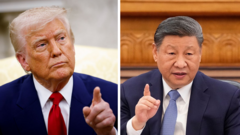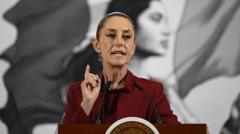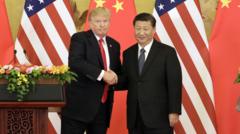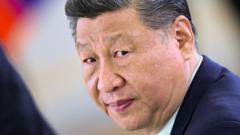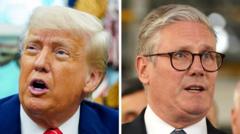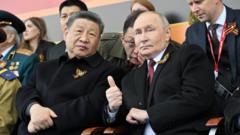The article examines the methodology behind the tariffs imposed by Donald Trump, indicating that they are not based on reciprocal trade agreements but rather aim to eliminate the US trade deficit with individual countries. Despite their intentions, economists argue that these tariffs may not significantly affect the overall trade balance.
Unpacking the Calculations Behind Trump's Tariff Regime
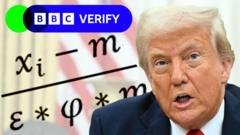
Unpacking the Calculations Behind Trump's Tariff Regime
How tariffs are established under Trump's administration, revealing their underlying calculations and economic implications.
\n
In recent months, President Donald Trump has implemented a 10% tariff on most imported goods from various nations, with increased fees for what he deems "worst offenders." But what methodology was utilized to establish these tariffs? BBC Verify delves into the calculations involved.
Initially, when Trump showcased a sizeable cardboard chart displaying the tariffs in the White House Rose Garden, many believed the rates were established through a blend of existing tariffs and various trade barriers, including regulations. However, a more complex formula released by the White House later revealed a clearer methodology.
The formula, while looking intricate, is straightforward: the trade deficit with a particular country is divided by total imports from that country, and then that result is halved. A trade deficit arises when a nation's imports surpass its exports.
For instance, the US has a significant trade deficit with China at $295 billion against total imports of $440 billion. This gives a division result of 67%, which, when halved, leads to a 34% tariff on Chinese imports. As for the European Union, the same calculation yields a 20% tariff rate.
Critics argue that these tariffs lack reciprocity, meaning they are not based on the tariffs charged by other nations against the US. Instead, the White House maintains that these tariffs aim to rectify the US goods trade deficit with each respective nation. Trump even imposed a 10% tariff on the UK, despite the US not having a trade deficit with the country.
Overall, more than 100 nations are encompassed under this new tariff structure. Trump believes that the US has been at a disadvantage in international trade, as it imports large quantities from other nations while struggling to compete with domestic industries.
Despite these intentions, economic analysts express skepticism regarding the effectiveness of this approach. Although bilateral trade deficits between the US and specific nations might see reductions, the overall national deficit is unlikely to shrink. Professor Jonathan Portes from King's College, London states, "Yes, it will reduce bilateral trade deficits... but there will obviously be lots of broader impacts that are not captured in the calculation."
Loading these tariffs, economists explain, could impose detrimental effects on the global economy. Unlike tariffs, trade deficits can arise for various legitimate reasons, including differing production costs related to climate, as highlighted by Thomas Sampson of the London School of Economics. He critiques the formula as lacking sound economic justification and warns of its broader ramifications.
The complexities of Trump's tariff policies underscore how recalibrating trade dynamics can yield mixed outcomes for both the US and its global partners.
In recent months, President Donald Trump has implemented a 10% tariff on most imported goods from various nations, with increased fees for what he deems "worst offenders." But what methodology was utilized to establish these tariffs? BBC Verify delves into the calculations involved.
Initially, when Trump showcased a sizeable cardboard chart displaying the tariffs in the White House Rose Garden, many believed the rates were established through a blend of existing tariffs and various trade barriers, including regulations. However, a more complex formula released by the White House later revealed a clearer methodology.
The formula, while looking intricate, is straightforward: the trade deficit with a particular country is divided by total imports from that country, and then that result is halved. A trade deficit arises when a nation's imports surpass its exports.
For instance, the US has a significant trade deficit with China at $295 billion against total imports of $440 billion. This gives a division result of 67%, which, when halved, leads to a 34% tariff on Chinese imports. As for the European Union, the same calculation yields a 20% tariff rate.
Critics argue that these tariffs lack reciprocity, meaning they are not based on the tariffs charged by other nations against the US. Instead, the White House maintains that these tariffs aim to rectify the US goods trade deficit with each respective nation. Trump even imposed a 10% tariff on the UK, despite the US not having a trade deficit with the country.
Overall, more than 100 nations are encompassed under this new tariff structure. Trump believes that the US has been at a disadvantage in international trade, as it imports large quantities from other nations while struggling to compete with domestic industries.
Despite these intentions, economic analysts express skepticism regarding the effectiveness of this approach. Although bilateral trade deficits between the US and specific nations might see reductions, the overall national deficit is unlikely to shrink. Professor Jonathan Portes from King's College, London states, "Yes, it will reduce bilateral trade deficits... but there will obviously be lots of broader impacts that are not captured in the calculation."
Loading these tariffs, economists explain, could impose detrimental effects on the global economy. Unlike tariffs, trade deficits can arise for various legitimate reasons, including differing production costs related to climate, as highlighted by Thomas Sampson of the London School of Economics. He critiques the formula as lacking sound economic justification and warns of its broader ramifications.
The complexities of Trump's tariff policies underscore how recalibrating trade dynamics can yield mixed outcomes for both the US and its global partners.



